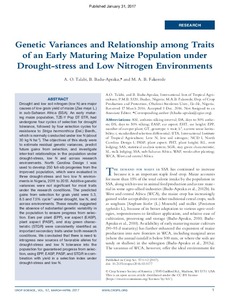| dc.contributor.author | Talabi, A.O. |
| dc.contributor.author | Badu-Apraku, B. |
| dc.contributor.author | Fakorede, M.A.B. |
| dc.date.accessioned | 2019-12-04T11:07:47Z |
| dc.date.available | 2019-12-04T11:07:47Z |
| dc.date.issued | 2017-01-31 |
| dc.identifier.citation | Talabi, A.O., Badu-Apraku, B. & Fakorede, M. (2017). Genetic variances and relationship among traits of an early maturing maize population under drought-stress and low nitrogen environments. Crop Science, 57, 1-12. |
| dc.identifier.issn | 0011-183X |
| dc.identifier.uri | https://hdl.handle.net/20.500.12478/1586 |
| dc.description | Article purchased |
| dc.description.abstract | Drought and low soil nitrogen (low N) are major causes of low grain yield of maize (Zea mays L.) in sub-Saharan Africa (SSA). An early maturing maize population, TZE-Y Pop DT STR, had undergone four cycles of selection for drought tolerance, followed by four selection cycles for resistance to Striga hermonthica (Del.) Benth., which is normally conducted under low N (about 30 kg N ha-1). The objectives of this study were to estimate residual genetic variances, predict future gains from selection, and investigate inter-trait relationships in the population under drought-stress, low N and across research environments. North Carolina Design I was used to develop 250 full-sib progenies from the improved population, which were evaluated in three drought-stress and two low N environments in Nigeria, 2011 to 2013. Additive genetic variances were not significant for most traits under the research conditions. The predicted gains from selection for grain yield were 5.3, 8.5 and 7.5% cycle-1 under drought, low N, and across environments. These results suggested the absence of substantial genetic variability in the population to ensure progress from selection. Ears per plant (EPP), ear aspect (EASP), plant aspect (PASP), and stay green characteristic (STGR) were consistently identified as important secondary traits under both research conditions. We concluded that there is need to introgress new sources of favorable alleles for drought-stress and low N tolerance into the population for guaranteed progress from selection, using EPP, EASP, PASP, and STGR in combination with yield in a selection index under drought-stress and low N. |
| dc.format.extent | 1-12 |
| dc.language.iso | en |
| dc.subject | Genetic Variances |
| dc.subject | Early Maturing Maize |
| dc.subject | Drought-Stress |
| dc.subject | Low Nitrogen Environments |
| dc.title | Genetic variances and relationship among traits of an early maturing maize population under drought-stress and low nitrogen environments |
| dc.type | Journal Article |
| dc.description.version | Peer Review |
| cg.contributor.crp | Maize |
| cg.contributor.affiliation | International Institute of Tropical Agriculture |
| cg.contributor.affiliation | Obafemi Awolowo University |
| cg.coverage.region | Africa |
| cg.coverage.region | West Africa |
| cg.coverage.country | Nigeria |
| cg.isijournal | ISI Journal |
| cg.authorship.types | CGIAR and developing country institute |
| cg.iitasubject | Maize |
| cg.iitasubject | Plant Genetic Resources |
| cg.journal | Crop Science |
| cg.howpublished | Formally Published |
| cg.accessibilitystatus | Open Access |
| local.dspaceid | 82222 |
| cg.targetaudience | Scientists |
| cg.identifier.doi | https://dx.doi.org/10.2135/cropsci2016.03.0177 |

